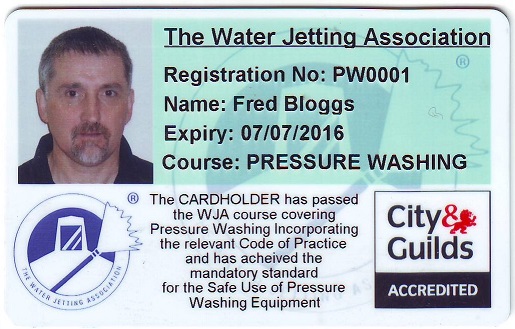1. REGISTRATION & INTRODUCTION
2. APPLICATIONS & MACHINES:
Effect of varying pressure/flow at the nozzle – range of jetting machines – configurations & categories (pressure washers)
3. LEGISLATION & THE WJA CODES OF PRACTICE:
Health & Safety at Work Act – WJA Codes of Practice – status, use and recognition by the HSE Management Regulations – Risk Assessment – PPE at Work Regulations – COSHH – Employer/Emplyee responsibilities – Enforcement Powers – other relevant legislation e.g. Environmental Protection Act / control of Pollution Act. Confined Spaces entry Requirements.
4. NOZZLES:
Jet principles – purpose of nozzles – power of water jet – jet pressure/flow characteristic – jet reaction force. Types of nozzle – forward facing, fixed & spinning jets, multi-jet fixed & spinning nozzles.
5. PUMPS:
Pump configuration – standard piston/plunger pump, positive displacement action, operating features, effects of blockages, variation of plunger sizes. Other pump configurations – diaphragm and intensifier types. Drive arrangements – engine/electric motor, hazardous area equipment. Water supply/delivery features – filtration equipment, boost feed pumps, pulsation dampers, jump-jet. Pressure safety relief options – relief valve/bursting disc. Pressure gauge features.
6. PRESSURE CONTROLS:
Dump & dry shut controls – fail-safe/selector versions, direct manual operation/remote operation via electric-pneumatic-hydraulic controls, automatic unloader valve for dry shut, pressure regulators and automatic off-load engine speed control systems.
7. WATER JETTING HOSE:
Hose construction & pressure ratings, external & internal damage possibilities, hazards arising from damaged hoses, inspection requirements. Hose end fittings, construction/assembly/testing. Connectors & hose end couplings – types & features. Bore size & flow ratings. Hose for general/high flow/small bore tube & pipe cleaning. Pressure drop due to flow through hose & lances – effect on pressure available at the nozzle.
8. HAZARDS:
Hazards arising directly from the water jet – from operational regime – from site environment.
9. INJURIES:
Effects of impact by high pressure water jet – nature of internal injuries caused – action in event of a jetting injury – awareness of possible absence of visual injury & use of WJA Medical Card.
10, PERSONAL PROTECTIVE EQUIPMENT:
General principles regarding use of PPE, as a last resort; Main body protection – limits on effectiveness against direct impact of water jet. Protection of head, hands, feet, hearing, respiration.
11. OPERATIONAL PROCEDURES:
Routine care & inspection – site preparations – preparations for operation – team operation. Safety ponts during operations – use of manual jetting gun, tube/pipe/drain cleaning nozzle/hose combinations & techniques. Safe use of non-standard equipment e.g. tee nozzle. Site shutdown & anti freeze procedures. Use of DO/DO NOT GUIDE.
12. SUMMARY:
Review of course content as above – with opportunity for any further discussion before Questionnaire.


